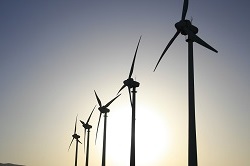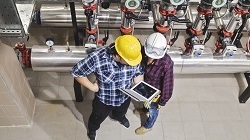Changes in consumer demand and new opportunities in renewable energy production are leading energy companies to invest in alternative sources, modernize their infrastructure and seek new revenue streams. This will continue as energy and utility companies come to grips with building smarter infrastructures and integrating powerful new technologies and analytics platforms. Colin Beaney, Global Industry Director for Energy and Utilities at IFS, looks at how energy companies can take advantage of the biggest trends shaping the market in 2017 and beyond.
2017: Traditional energy suppliers will adopt a start-up mindset to move into renewables
Investment in renewables now represents over half of new power capacity around the world, and this market will grow 13% more in the next five years than was predicted last year, driven by wind and solar. Energy suppliers are now looking to decentralize their power capacity and diversify into renewables. It’s a question of both modernizing the business and future-proofing profitability.
 To date, traditional energy firms have modernized their operations and fended off the competition by establishing dedicated innovation units to experiment and validate new opportunities. However, with competition rising from all corners of the industry, outside of the traditionally defined market and also from new start-ups, the issue of protecting revenue streams (let alone growing them) is too great for many firms to solely rely on one dedicated innovation unit to ensure they remain competitive.
To date, traditional energy firms have modernized their operations and fended off the competition by establishing dedicated innovation units to experiment and validate new opportunities. However, with competition rising from all corners of the industry, outside of the traditionally defined market and also from new start-ups, the issue of protecting revenue streams (let alone growing them) is too great for many firms to solely rely on one dedicated innovation unit to ensure they remain competitive.
To jump quickly into a new renewable sector, whether on land, sea or in the air and wherever the opportunity arises, means traditional energy companies should consider setting up an entirely new business unit or separate financial entity purely focused on renewables – essentially starting a new business from the ground up — and fast.
To succeed in doing this, the energy companies will need more agile and quick-to-deploy organizations and technical platforms, which for speed and cost reasons (more opex than capex) will likely be based in the cloud. This means reinventing key processes such as finance, resource planning, field service support and asset and supply chain management to have them up and running in a matter of weeks and being able to change them on the go. To make all of this happen, energy suppliers must truly adopt new, start-up-like mindsets in the coming year.
2017: The consumer is back in the driving seat. The shift from energy supplier to lifestyle provider
We are now seeing the rise of a whole new energy ecosystem. IDC Predicts that by 2020, 2.5GW of electricity will be generated by 20% of Fortune G500 companies — not traditional energy companies. Add to this consumers with their own solar roofing or wind turbines who want to sell excess energy back to the grid, and you start to see energy and utilities providers transforming from centralized supply companies to more distributed, bi-directional service providers.
Consumers demand choice and flexibility in when and how they consume – and now supply – power. This will only be achieved through the evolution of “smart grids” where sensors and smart meters will be able to provide the consumer with a more granular level of detail of power usage, really. With a more accurate, real-time, account of power usage, consumers will be able to manage and optimize their own “smart usage.”
 But, the shift from an energy supplier to “lifestyle provider” will require a much more dynamic and optimized approach to maintenance and field service and provide the high level of service this entails. To build and maintain smart infrastructure, field service technicians and engineers need to be empowered by connected technologies.
But, the shift from an energy supplier to “lifestyle provider” will require a much more dynamic and optimized approach to maintenance and field service and provide the high level of service this entails. To build and maintain smart infrastructure, field service technicians and engineers need to be empowered by connected technologies.
This means that by 2017 the companies that start to digitally transform their enterprise business processes by integrating the new technologies, augmented reality and voice applications) will see better asset management, better planning, better execution and a faster level of service to keep those demanding consumers satisfied.
Question: When is a drone a robot? Answer: When it’s cutting grass — regulations and compliance issues come to the fore in 2017
Drones are fast becoming the norm in the energy market, as another pair of eyes to visually assess pipelines, powerlines or other assets. In 2017, I expect to see a number of developments. First to see data from drones integrated directly with enterprise software platforms to automatically generate work orders when finding faults. This can be sent straight to engineers in the field for a speedy response and minimal disruption to the grid.
 I see the use of drones not stopping at inspections. As drones become more adaptable, there is the real potential for them to carry out repairs and manual tasks themselves. We are still some way away from drones taking autonomous decisions, but with the current rate of innovation in drone technology, it’s not hard to envisage a future where at least simple repair tasks can be performed remotely by drones.
I see the use of drones not stopping at inspections. As drones become more adaptable, there is the real potential for them to carry out repairs and manual tasks themselves. We are still some way away from drones taking autonomous decisions, but with the current rate of innovation in drone technology, it’s not hard to envisage a future where at least simple repair tasks can be performed remotely by drones.
But as drones become more commonplace in 2017, I expect to see more regulations and compliance issues and not just from air safety. A recent ruling in Sweden banned the unpermitted use of camera drones. Comprehensive regulations are still yet to be sorted for 2017, so being aware of the shifting landscape in different geographies will be key to remaining compliant.
2017 and the arrival of machine intuition: the digitization of assets
From IP-enabled sensors to digital twins, assets will become increasingly digitalized as we move through 2017 and leverage the advanced analytics.
Machine learning is at the center of the evolution of Industry 4.0. Automated intelligent analytics platforms can learn from the huge aggregate of data sets collected from assets across the entire enterprise and deliver greater insights on both asset performance and the status of the asset.
Analytics are leading the development of predictive capabilities. New models produced by automated machine learning will take all the data from the smart infrastructure to produce alerts about failing assets or anomalous readings ahead of asset malfunction, with detailed information about what corrective actions need to be taken before operations are disrupted by component failure.
 But all this is to no real value unless the foresight offered by the operational intelligence produced is integrated with existing enterprise asset management (EAM) solutions — so the insight becomes a real work-order, with information about the parts, tools and action required by the right engineer.
But all this is to no real value unless the foresight offered by the operational intelligence produced is integrated with existing enterprise asset management (EAM) solutions — so the insight becomes a real work-order, with information about the parts, tools and action required by the right engineer.
2017 is presenting energy businesses, both large and small, with a new world order, one of exciting new business opportunities, of greater connectivity, of more automation in the field and of more data to produce more intelligence to run their businesses. And there’s the rub. They are businesses, and at the heart of the business is enterprise software that needs to be on side with all these developments, ready and able to integrate, analyze and deliver, quickly and easily. Only then will energy companies be able to efficiently and profitably provide smart services and smart energy to their growing number of smart consumers.
Do you have questions or comments?
We’d love to hear them so please leave us a message below.
Saheli Ghosh
Hey Colin Beaney,
I’m Saheli Ghosh, and i write at industrial utility management @Energy Plus India. I’m also a regular contributor at how to choose the right industrial utility service provider in India. I’ve been following the 4 trends lighting up the energy & utilities industry in 2017 for quite some time now, and i have even mentioned your article about energy and utility while back.
Anyway, I’m writing to you because i have some really interesting content ideas that i strongly feel will be prefect for ifsworld.com’s audience.
I can send you the topics i have in mind if you’re still open to new guest authors.
I appreciate the time, and really looking forward to working together.
Cheers!